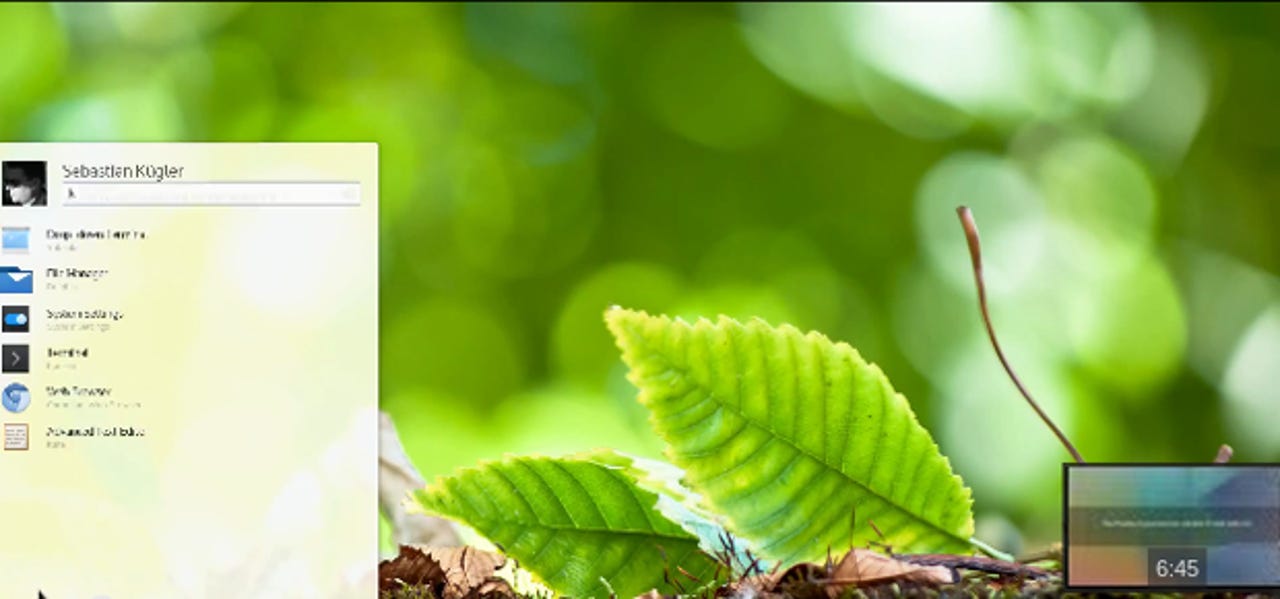KDE Plasma 5 Linux desktop arrives

When KDE made a radical change to its popular Linux desktop in 2008 in KDE 4, I hated it. Over a year and many changes later, I finally found KDE 4.3 usable. This time, with the just-released KDE Plasma 5, I didn't have to wait for it to be usable. The new KDE is already good to go.

That isn't to say that KDE 5 is perfect. It's not.
The new default Breeze Plasma desktop theme has a chunky, half-baked look to it that's not at all to my taste. However, it's easy enough to change to another theme.
- Read more: Six Clicks: 2014's top Linux desktops
What really struck me about this new desktop is how fast it is. KDE's developers have clearly been hard at work tuning the desktop for maximum performance. The speed boost starts at a very low level. The desktop is based on a new, full hardware-accelerated graphics stack using an OpenGL ES scenegraph, with Plasma itself using Qt 5 and KDE's recently released Frameworks 5 libraries.
KDE's other new features include:
Featured
Converged shell: The "converged Plasma shell" that loads up the desktop in Plasma 5.0 can be extended for other user experiences. This lays the base for a converged user experience that brings up a suitable user interface for a given target device. User experiences can be switched dynamically at runtime. So, for instance, if you plug in a keyboard and a mouse, you'll get access to a desktop-style UI; without them, it will default to a touchscreen tablet-style interface.
Modernized launchers: The application launchers' user interfaces have been reworked. Among the changes are a visually redesigned Kickoff application launcher, a new, menu-like launcher called Kicker and a new, QtQuick-based interface for the KRunner shell program launcher.
Workflow improvements in the notification area: The notification area has been cleaned up, sporting a more integrated look. It has fewer popup windows and quicker transitions between, for example, power management and networks settings. The result is a more distraction-free interaction UI with better visual coherence.
Better support for high-density (high-DPI) displays: Support for high-density displays has been improved. Many parts of the UI now take the physical size of the display into account. This leads to better usability and display on screens with very small pixels, such as Retina displays.
Another nice overall change is that, unlike the transition to KDE 4 (which broke many of the old ways KDE 3 had of doing things), you'll have no trouble putting KDE 5 to use if you're comfortable with KDE 4.
The one exception to this is that the new Kickoff menu no longer has a visible search field. So if you want to search for a file or an application, you just start typing and the search window will open. This puzzled me at first and I know it's going to confuse new users. If you find Kickoff's new look too distracting, you can always right-click on the menu icon and select Switch to Classic Menu Style.
Last, but not least, there are still a few bugs. The one that annoyed me the most is that the Plasma calendar doesn't display events. KDE tends to be good about fixing bugs promptly and this one screams to be fixed sooner rather than later.
All in all, however, I found this new KDE Plasma 5 to be a good, solid desktop. Unlike GNOME 3, which disappointed users so much that its release led to numerous GNOME desktop forks such as Ubuntu's Unity, Mint's Cinammon, and MATE, KDE users will be pleased with this new model KDE.
Want to give it a try? KDE 5 is packaged and ready to go on Arch Linux, AOSC, Kubuntu, KaOS and openSUSE. You can also, of course, download and install it from the source code. The one thing you can't do, however, is try to run KDE 5 on the same desktop with KDE 4 installed. You'll need to uninstall the older version of KDE.
That said, I expect most, if not all, KDE users to really enjoy this new release. Have fun!
Related stories: